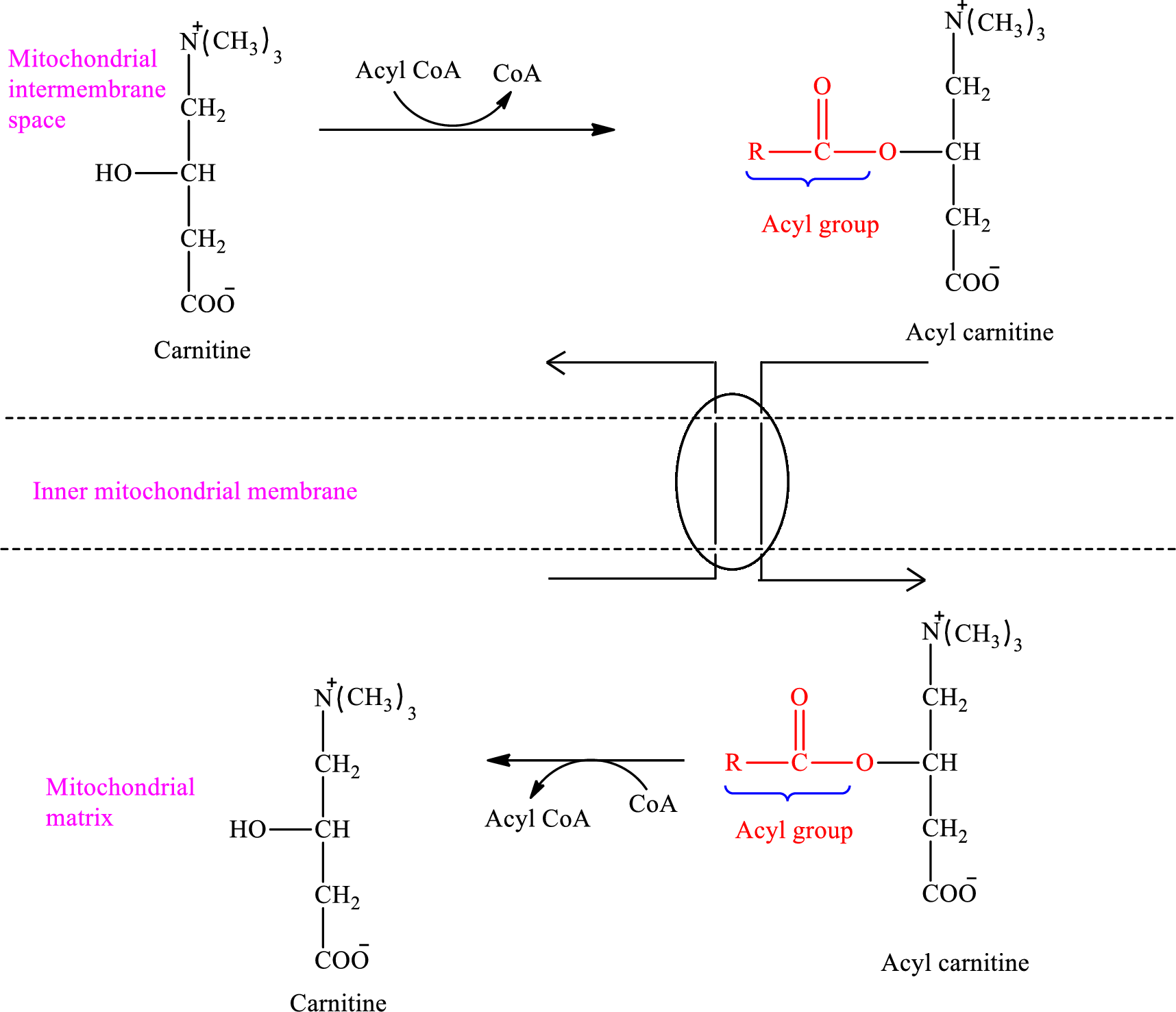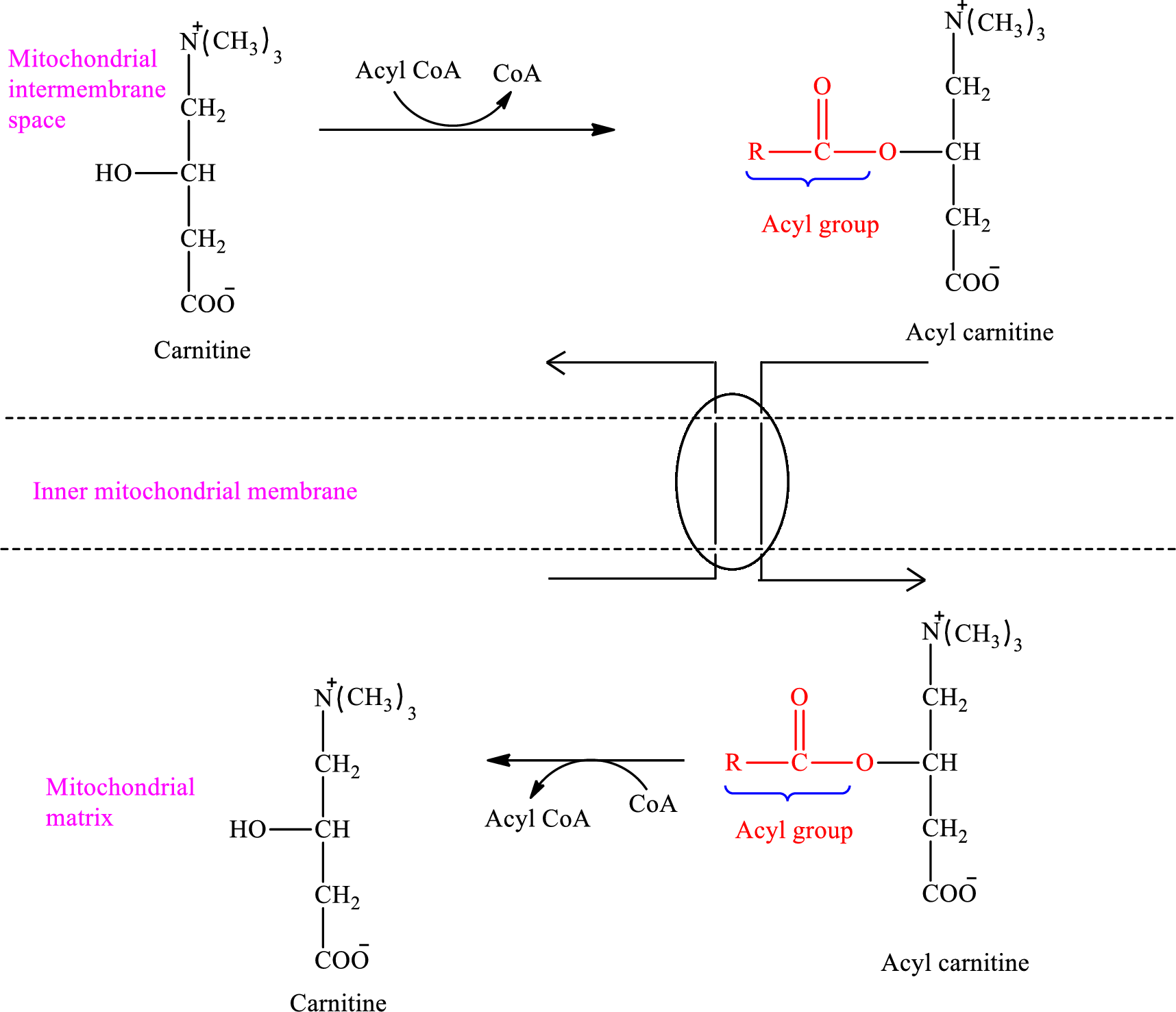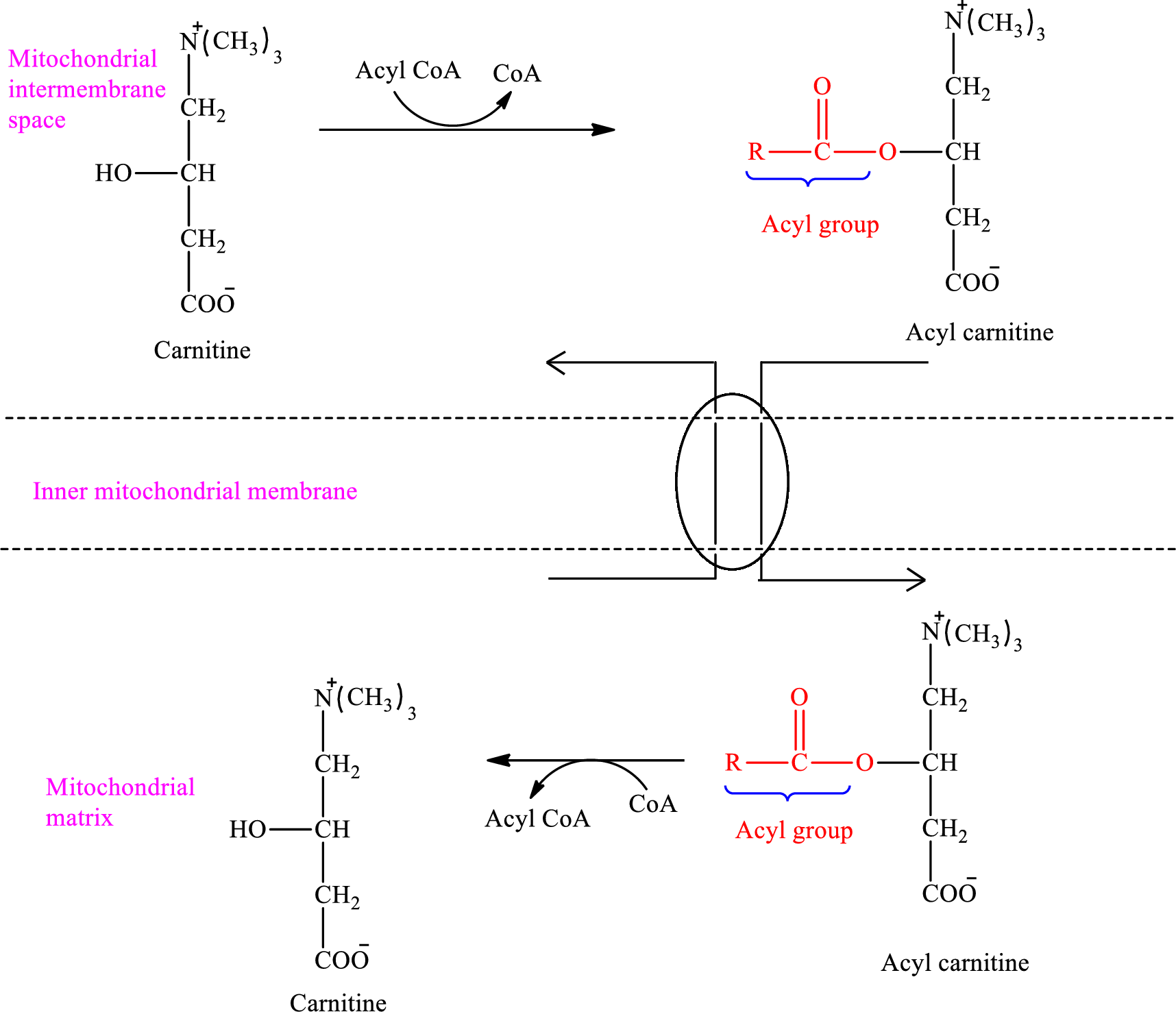
Concept explainers
(a)
Interpretation:
Whether “
Concept Introduction:
The fatty acids are broken down to provide energy. The breakdown of fatty acids is a three parts process. In the first part, the fatty acid is activated. In the second part, the transportation of fatty acid into the mitochondrial matrix is facilitated by a shuttle mechanism. In the third part, the fatty acid is readily oxidized, cycling through a series of four reactions.
The
The first stage of fatty acid oxidation is the activation of fatty acids in the outer mitochondrial membrane. The fatty acid is activated by
(a)
Answer to Problem 25.25EP
Explanation of Solution
The enzymes that are needed for the oxidation of fatty acid are located in the mitochondrial matrix. Acyl CoA cannot pass through the inner mitochondrial membrane to the mitochondrial matrix because it is too large. A shuttle mechanism that involves the molecule carnitine effects the entry of Acyl CoA into the mitochondrial matrix.
An overview of the transportation of Acyl CoA in the carnitine shuttle system associated with the

Therefore, Acyl CoA is encountered as a reactant in the intermembrane space.
(b)
Interpretation:
Whether “carnitine enters the inner mitochondrial membrane” in the mitochondrial matrix or in the mitochondrial intermembrane space in the carnitine shuttle system associated with the
Concept Introduction:
The fatty acids are broken down to provide energy. The breakdown of fatty acids is a three parts process. In the first part, the fatty acid is activated. In the second part, the transportation of fatty acid into the mitochondrial matrix is facilitated by a shuttle mechanism. In the third part, the fatty acid is readily oxidized, cycling through a series of four reactions.
The
The first stage of fatty acid oxidation is the activation of fatty acids in the outer mitochondrial membrane. The fatty acid is activated by
(b)
Answer to Problem 25.25EP
Carnitine enters the inner mitochondrial membrane in the mitochondrial matrix.
Explanation of Solution
The enzymes that are needed for the oxidation of fatty acid are located in the mitochondrial matrix.
An overview of the transportation of

Carnitine molecule shuttles the activated fatty acid molecules across the inner mitochondrial membrane. Therefore, carnitine enters the inner mitochondrial membrane in the mitochondrial matrix.
(c)
Interpretation:
Whether “carnitine is converted to acyl carnitine” in the mitochondrial matrix or in the mitochondrial intermembrane space in the carnitine shuttle system associated with the
Concept Introduction:
The fatty acids are broken down to provide energy. The breakdown of fatty acids is a three parts process. In the first part, the fatty acid is activated. In the second part, the transportation of fatty acid into the mitochondrial matrix is facilitated by a shuttle mechanism. In the third part, the fatty acid is readily oxidized, cycling through a series of four reactions.
The
The first stage of fatty acid oxidation is the activation of fatty acids in the outer mitochondrial membrane. The fatty acid is activated by
The enzymes that are needed for the oxidation of fatty acid are located in the mitochondrial matrix.
(c)
Answer to Problem 25.25EP
Carnitine is converted to acyl carnitine in the mitochondrial intermembrane space.
Explanation of Solution
Acyl group present in
An overview of the transportation of

Therefore, carnitine is converted to acyl carnitine in the mitochondrial intermembrane space.
(d)
Interpretation:
Whether “free
Concept Introduction:
The fatty acids are broken down to provide energy. The breakdown of fatty acids is a three parts process. In the first part, the fatty acid is activated. In the second part, the transportation of fatty acid into the mitochondrial matrix is facilitated by a shuttle mechanism. In the third part, the fatty acid is readily oxidized, cycling through a series of four reactions.
The
The first stage of fatty acid oxidation is the activation of fatty acids in the outer mitochondrial membrane. The fatty acid is activated by
The enzymes that are needed for the oxidation of fatty acid are located in the mitochondrial matrix.
(d)
Answer to Problem 25.25EP
Free
Explanation of Solution
Acyl group present in
An overview of the transportation of

Therefore, free
Want to see more full solutions like this?
Chapter 25 Solutions
EBK GENERAL, ORGANIC, AND BIOLOGICAL CH
- in the scope of the SCH4U course! please show all steps as im still learning how to format my answers in the format given, thank you!arrow_forwardhelp me solve this HWarrow_forwardMolecules of the form AH2 can exist in two potential geometries: linear or bent. Construct molecular orbital diagrams for linear and bent CH2. Identify the relevant point group, include all of the appropriate symmetry labels and pictures, and fill in the electrons. Which geometry would you predict to be more stable, and why? (Please draw out the diagram and explain)arrow_forward
- Indicate the variation in conductivity with concentration in solutions of strong electrolytes and weak electrolytes.arrow_forwardThe molar conductivity of a very dilute solution of NaCl has been determined. If it is diluted to one-fourth of the initial concentration, qualitatively explain how the molar conductivity of the new solution will compare with the first.arrow_forwardWhat does the phrase mean, if instead of 1 Faraday of electricity, Q coulombs (Q/F Faradays) pass through?arrow_forward
- What characteristics should an interface that forms an electrode have?arrow_forwardFor a weak acid AcH, calculate the dissociated fraction (alpha), if its concentration is 1.540 mol L-1 and the concentration [H+] is 5.01x10-4 mol L-1.arrow_forwardIf the molar conductivity at infinite dilution of HAC is A0 = 390.5 S cm² mol¹. Calculate the Arrhenius conductivity of a 9.3% by weight solution of HAc with a pH of 3.3. Data: molecular weight of HAC is 60.05 g/mol and the density of the solution is 1 g/cm³.arrow_forward
- If the molar conductivity at infinite dilution of HAC is A0 = 390.5 S cm² mol¹. Calculate the Arrhenius conductivity of a 9.3% by weight solution of HAc with a pH of 3.3. Data: molecular weight of HAC is 60.05 g/mol and the density of the solution is 1 g/cm³.arrow_forwardIf the molar conductivity at infinite dilution of HAC is A0 = 390.5 S cm² mol¹. Calculate the Arrhenius conductivity of a 9.3% by weight solution of HAc with a pH of 3.3. Data: molecular weight of HAC is 60.05 g/mol and the density of the solution is 1 g/cm³.arrow_forwardDetermine the distance between the metal and the OHP layer using the Helm- holtz model when the electrode's differential capacitance is 145 μF cm². DATA: dielectric constant of the medium for the interfacial zone &r= lectric constant of the vacuum &0 = 8.85-10-12 F m-1 = 50, die-arrow_forward
 Chemistry for Today: General, Organic, and Bioche...ChemistryISBN:9781305960060Author:Spencer L. Seager, Michael R. Slabaugh, Maren S. HansenPublisher:Cengage Learning
Chemistry for Today: General, Organic, and Bioche...ChemistryISBN:9781305960060Author:Spencer L. Seager, Michael R. Slabaugh, Maren S. HansenPublisher:Cengage Learning Introduction to General, Organic and BiochemistryChemistryISBN:9781285869759Author:Frederick A. Bettelheim, William H. Brown, Mary K. Campbell, Shawn O. Farrell, Omar TorresPublisher:Cengage Learning
Introduction to General, Organic and BiochemistryChemistryISBN:9781285869759Author:Frederick A. Bettelheim, William H. Brown, Mary K. Campbell, Shawn O. Farrell, Omar TorresPublisher:Cengage Learning General, Organic, and Biological ChemistryChemistryISBN:9781285853918Author:H. Stephen StokerPublisher:Cengage Learning
General, Organic, and Biological ChemistryChemistryISBN:9781285853918Author:H. Stephen StokerPublisher:Cengage Learning Organic And Biological ChemistryChemistryISBN:9781305081079Author:STOKER, H. Stephen (howard Stephen)Publisher:Cengage Learning,
Organic And Biological ChemistryChemistryISBN:9781305081079Author:STOKER, H. Stephen (howard Stephen)Publisher:Cengage Learning,



